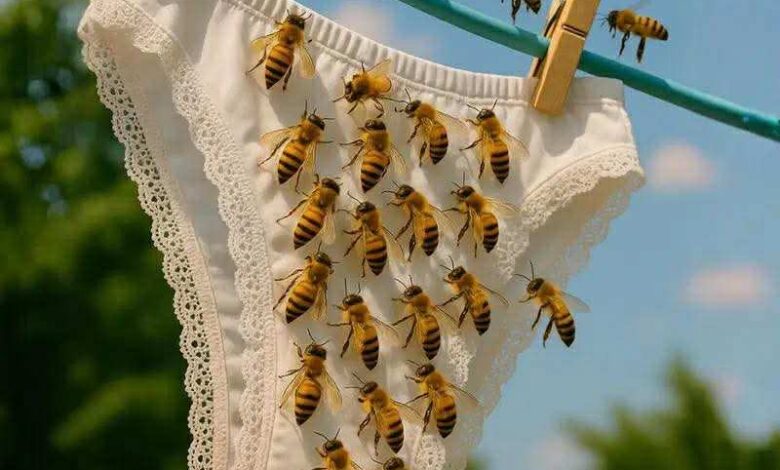
Most people toss their clothes into a dryer without a second thought, chasing convenience and speed. Sun-drying, meanwhile, gets brushed off as old-fashioned even though it’s gentler on fabrics, cheaper, and naturally refreshing. Clothing hung outside smells cleaner, lasts longer, and benefits from the sun’s natural disinfecting power. But sunny days also bring uninvited visitors—especially bees.
If you’ve ever stepped outside to grab your laundry and found bees resting on shirts or towels, it can be confusing or even alarming. But the truth is simple: bees aren’t trying to bother you. They’re following nature’s cues, and your laundry—without you realizing it—gives off signals that mimic flowers.
Bees rely almost entirely on their sense of smell to survive. Their world revolves around scent trails, chemical signals, and the faintest traces of nectar floating through the air. Modern detergents and fabric softeners contain fragrance molecules intentionally crafted to smell “fresh,” “floral,” or “clean.” To humans, these scents are pleasant. To bees, they’re nearly indistinguishable from the chemical compounds real flowers produce.
When freshly washed clothes hang outside in the sun, the heat intensifies those scents. The wind spreads them farther. What reaches a bee’s antennae is a trail that screams nectar source here. Even if the fragrance is synthetic, bees can’t tell the difference. Pastel colors, whites, and light fabrics make the illusion even stronger because they resemble the flowers bees naturally gravitate toward. To them, your laundry looks and smells like a patch of blossoms waving gently in the breeze.
Colors play a bigger role than most people realize. Bees don’t see the world the way humans do—they’re drawn toward blues, violets, whites, yellows, and other light tones. A pale sheet or a soft yellow shirt moving softly in the wind can trick their instincts. Combine that with warm, floral-scented fabric emitting a steady, invisible signal, and your clothesline suddenly becomes a nectar hotspot worth investigating.
They land, explore, sniff around, and quickly realize there’s no reward waiting for them. But bees don’t sting unless they feel cornered or threatened. If one ends up on your laundry, it’s not aggressive—it’s curious. It’s doing its job, trying to locate food for its hive. Once it figures out there’s nothing there, it moves on.
Even so, not everyone wants bees lingering on their clean clothes. There are simple ways to discourage them without harming them.
One of the easiest methods is to hang laundry in the shade instead of direct sun. Shade reduces the warmth that intensifies detergent scents, making the clothes less attractive to bees. It also alters the way colors reflect light, reducing the visual cues bees use to navigate. If full shade isn’t an option, early morning or late afternoon drying—when the sun is weaker—can help reduce bee activity around the clothesline.
Another solution is choosing lightly scented or unscented detergents and softeners. These products produce fewer fragrance signals that mimic flowers, so bees are less likely to mistake your laundry for a food source. Natural or hypoallergenic detergents often have minimal aroma and are gentler on sensitive skin—and on curious pollinators.
Some people try shaking their laundry before bringing it inside. A quick flick dislodges any bee that might have landed. Just remember to stay calm. Bees respond to movement, tone, and vibration. A gentle shake is enough; frantic flapping is not.
It’s worth recognizing that bees serve an enormous purpose beyond the occasional inconvenience they might cause. They’re among the world’s most critical pollinators. Without them, crops would fail, ecosystems would collapse, and food supplies would shrink dramatically. Fruits, vegetables, nuts, seeds—these depend on bees moving from flower to flower, carrying pollen and sustaining the cycle of growth.
So when a bee lands on your laundry, it isn’t a threat. It’s a tiny, overworked creature doing one of the most important jobs in the natural world. It doesn’t want your shirt—it wants a flower. Your detergent fooled it for a moment. Nothing more.
If you see one, give it a second to figure out the mistake. It will leave. Bees don’t linger where there’s no nectar to collect. And they never sting unless pushed into a corner. Their instinct is survival, not aggression. Every sting they give costs them their life, so they avoid it whenever possible.
Still, it’s understandable to prefer a bee-free laundry experience. That’s why a few adjustments—using fragrance-light detergents, drying in the shade, or choosing a different time of day—can make a big difference. Small changes for you, major signals for them.
At the end of the day, outdoor drying offers benefits that modern appliances can’t match. The sun brightens whites naturally. Fresh air lifts away lingering odors. Fabrics come off the line crisp and clean without the wear and tear of tumbling heat. And with a few mindful steps, you can enjoy all of that without attracting curious pollinators.
The next time you step outside and spot a bee inspecting your laundry, remember what brought it there. It isn’t danger—it’s biology. It’s the echo of nature’s design, where scent and color guide even the smallest creatures. And though the bee may have mistaken your fabrics for flowers, it means no harm.
A calm gesture, a little patience, and a few smart drying habits are all it takes to keep both your clothes and our planet’s most vital pollinators safe.
If more people understood why bees behave this way, fewer would panic or reach for harmful solutions. A bit of awareness goes a long way. And when we choose to coexist—especially with creatures as essential as bees—everyone benefits.
Fresh laundry, unharmed bees, and a community that understands its environment just a little better. That’s a win across the board.